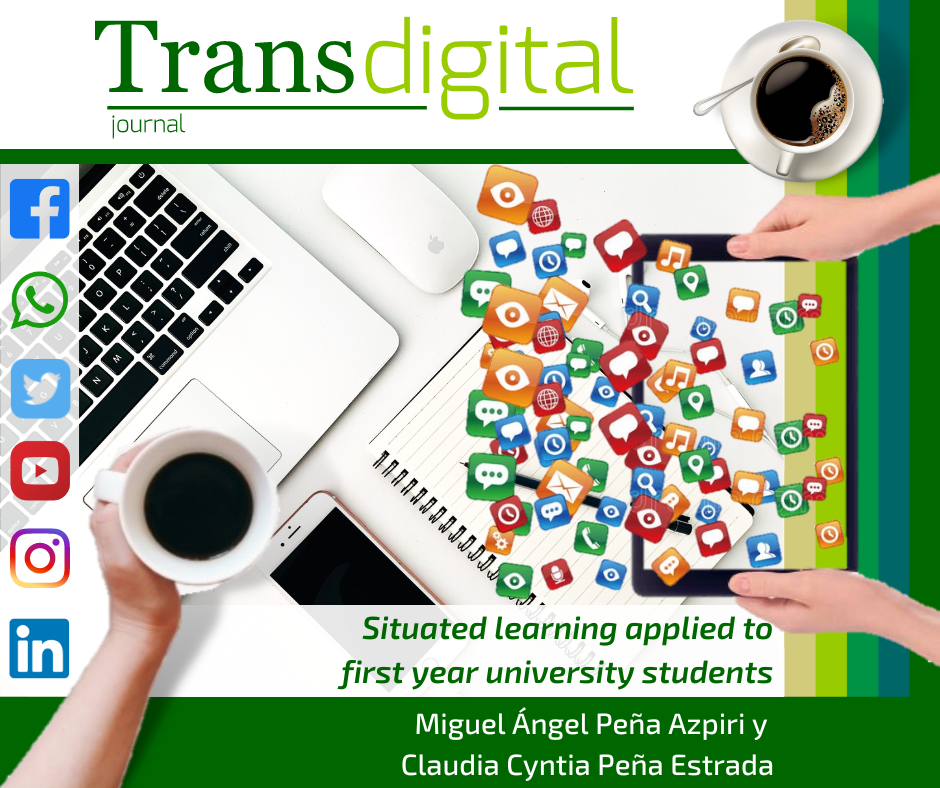Situated learning applied to first year university students
DOI:
https://doi.org/10.56162/transdigital130Keywords:
situated learning, online learning, Higher education, multimedia teachingAbstract
The first year at the university is important for students to become interested in their field of study and forge their professional path. However, frequently this does not happen because they are not attracted by the training material. Augmented situated learning with multimedia allows students to be exposed to significant scenarios that can favor their interest early on. In this study, a quasi-experimental design with pre- and post-tests and a control group was applied to a sample of 62 students to observe the effect of using situated digital content to support the learning of first-year college students. Findings suggest that the students who used situated digital multimedia content increased their learning performance than that of the control group, in addition to the fact that the students in the experimental group showed greater interest in interacting with educational material in different digital media. In this sense, incorporating digital and multimedia educational material with situational characteristics that allow first-year university students to experience significant scenarios improves their learning outcomes and helps them better adapt to the educational process.
References
Altomonte, S., Logan, B., Feisst, M., Rutherford, P. and Wilson, R. (2016). Interactive and Situated Learning in Education for Sustainability. En International Journal of Sustainability in Higher Education (Vol. 17, Issue 3, pp. 417–443). https://doi.org/10.1108/IJSHE-01-2015-0003
Bozkurt, A. (2016). Augmented reality with mobile and ubiquitous learning: Immersive, enriched, situated, and seamless learning experiences. En Digital Tools for Seamless Learning (Issue January, pp. 27–41). https://doi.org/10.4018/978-1-5225-1692-7.ch002
Domingo-Coscollola, M., Bosco-Paniagua, A., Carrasco-Segovia, S. and Sánchez-Valero, J.-A. (2019). Fomentando la competencia digital docente en la universidad: Percepción de estudiantes y docentes. Revista de Investigación Educativa, 38(1), 167–182. https://doi.org/10.6018/rie.340551
Donaldson, T., Fore, G. A., Filippelli, G. M. and Hess, J. L. (2020). A systematic review of the literature on situated learning in the geosciences: beyond the classroom. International Journal of Science Education, 42(5), 722–743. https://doi.org/10.1080/09500693.2020.1727060
Greenhow, C. and Chapman, A. (2020). Social distancing meet social media: digital tools for connecting students, teachers, and citizens in an emergency. Information and Learning Sciences, 121(5/6), 341–352. https://doi.org/10.1108/ILS-04-2020-0134
Hedrick, T.E., Bickman, L. y Rog, D.J. (1993). Applied research design. A practical guide. Sage. https://dx.doi.org/10.4135/9781412983457
Martinic, S. and Villalta, M. (2015). La gestión del tiempo en la sala de clases y los rendimientos escolares en escuelas con jornada completa en Chile. Perfiles educativos, 37, 28–49. https://doi.org/10.22201/iisue.24486167e.2015.147.47260
Neuhäuser, M. (2011). Wilcoxon–Mann–Whitney Test. En International Encyclopedia of Statistical Science (pp. 1656–1658). Springer Berlin Heidelberg. https://doi.org/10.1007/978-3-642-04898-2_615
Nobre, A. M. de J. F. (2018). Multimedia technologies and online task-based foreign language teaching-learning. Tuning Journal for Higher Education, 5(2), 75–97. https://doi.org/10.18543/tjhe-5(2)-2018pp75-97
Parrino, M. del C. (2010, December 8). Deserción en el primer año universitario. Dificultades y logros. X Colóquio Internacional Sobre Gestão Universitária Na América Do Sul. http://repositorio.ufsc.br/xmlui/handle/123456789/96620
Patriarca, M. C. (2013). La deserción en el inicio de la vida universitaria. Estudio contextualizado en la Escuela de Economía y Negocios de la Universidad Nacional de San Martin. Revista Argentina de Educación Superior, 6, 119–141.
Pocek, J., Politis, D. and Gabrielsson, J. (2022). Entrepreneurial learning in extra-curricular start-up programs for students. International Journal of Entrepreneurial Behavior & Research, 28(2), 325–345. https://doi.org/10.1108/IJEBR-04-2020-0206
Reyes, N. and Meneses, A. L. (2020). Una revisión crítica de los factores psicosociales asociados al abandono universitario en primer año. Congresos CLABES, 82–90. https://revistas.utp.ac.pa/index.php/clabes/article/view/2627
Romero Ariza, M. (2010). El aprendizaje experiencial y las nuevas demandas formativas. Revista de Antropología Experimental, 10, 89–102.
Santos-Ellakuria, I. (2019). Fundamentos para el aprendizaje significativo de la biodiversidad basados en el constructivismo y las metodologías activas. Revista de Innovación y Buenas Prácticas Docentes, 8(2), 90–101.
Silva Laya., M. (2011). El primer año universitario. Un tramo crítico para el éxito académico. Perfiles Educativos, 33(spe), 102–114.
Suárez, R. (2002). La educación. Estrategias de enseñanza-aprendizaje, teorías educativas. Trillas.
Viciana, V., Fernández Revelles, A. B., Linares, M., Espejo, T., Puertas, P. and Chacón, R. (2018). Los Estudios Universitarios y el Mindfulness. Una Revisión Sistemática. REICE. Revista Iberoamericana Sobre Calidad, Eficacia y Cambio En Educación, 16.1(2018). https://doi.org/10.15366/reice2018.16.1.008
Westerlund, K. (2021). “And the Word was made flesh?” – Exploring young people’s situated learning in leadership and spirituality in a secular context. Journal of Youth and Theology, 20(2), 142–164. https://doi.org/10.1163/24055093-02002006
Wu, T.-T., Huang, Y.-M., Chao, H.-C. and Park, J. H. (2014). Personalized English reading sequencing based on learning portfolio analysis. Information Sciences, 257, 248–263. https://doi.org/10.1016/j.ins.2011.07.021
Zhang, M. (2020). Virtual Situated Learning of Spoken English Based on Computer Simulation Technology. International Journal of Emerging Technologies in Learning (IJET), 15(04), 206. https://doi.org/10.3991/ijet.v15i04.12939

Downloads
Autor de correspondencia
El autor de correspodencia se identifica con el siguiente símbolo: *Published
How to Cite
License
Copyright (c) 2022 Miguel Ángel Peña Azpiri, Claudia Cyntia Peña Estrada

This work is licensed under a Creative Commons Attribution 4.0 International License.
All articles in Transdigital are licensed under a Creative Commons Attribution 4.0 International License. Authors hold the copyright and retain publishing rights without restrictions.









